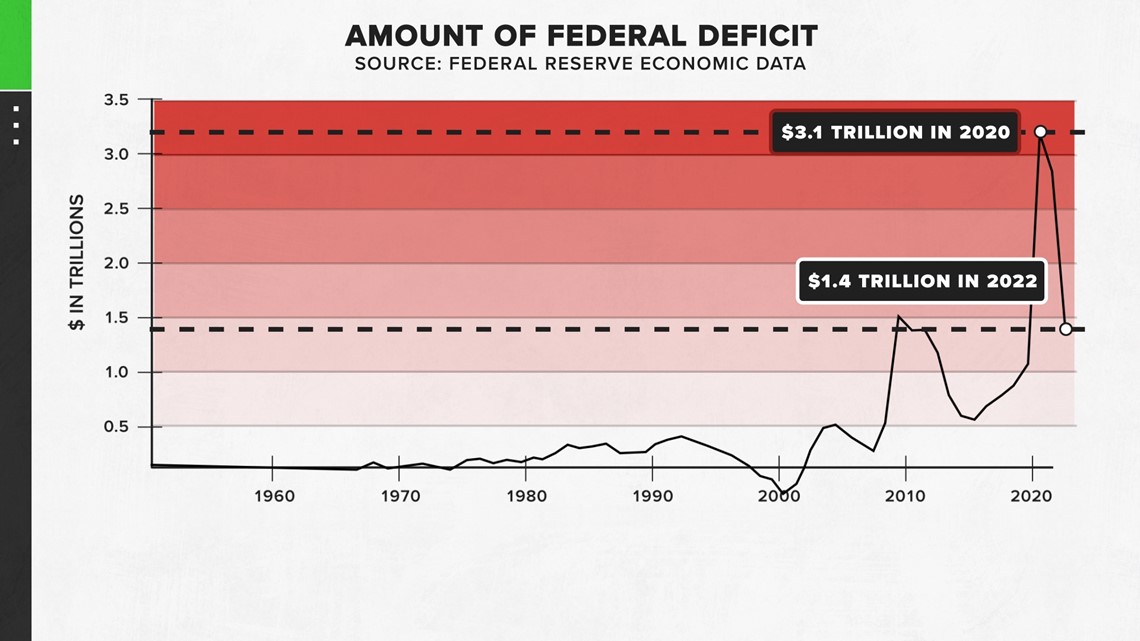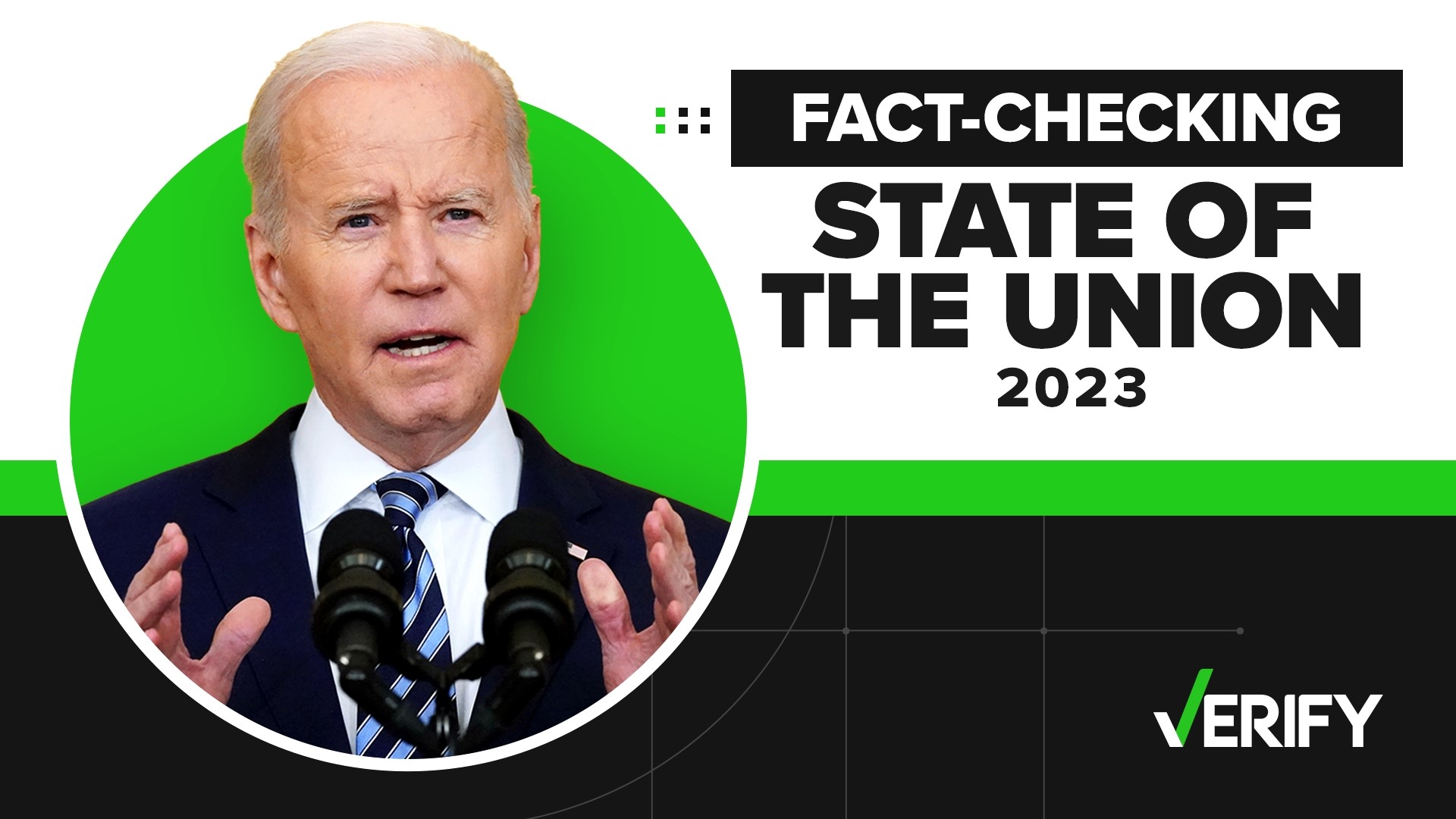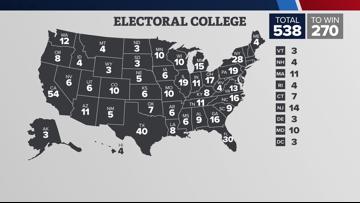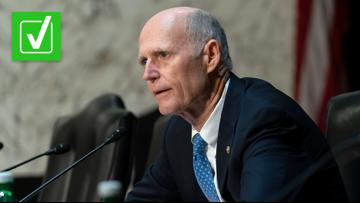President Joe Biden delivered his second State of the Union address to a split Congress on Tuesday, Feb. 7, with Republicans controlling the House and Democrats controlling the Senate. Biden addressed some of the most pressing issues facing Americans at home and abroad, including the uncertain economic climate, inflation, gun violence and the war in Ukraine. In addition, he credited his administration with wins from the past year, such as reducing the deficit and capping insulin prices.
Following Biden's address, Arkansas Governor Sarah Huckabee Sanders delivered a brief response for the GOP, where she called for a new generation of Republican leadership.
The VERIFY team fact-checked claims from Biden’s address and the GOP response.
THE CLAIM
President Biden: “My administration cut the deficit by more than $1.7 trillion – the largest deficit reduction in American history.”
THE SOURCES
- The Federal Reserve
- U.S. Department of the Treasury
- Maya MacGuineas, president of the bipartisan Committee for a Responsible Federal Budget
THE ANSWER
The deficit did shrink by a record amount in the last two years, as Biden claimed. But his claim is missing important context attributing this decline to the end of temporary COVID-19 relief spending.
WHAT WE FOUND
A budget deficit is the result of the government spending more money than it receives in revenue from taxes and other sources in a given year.
The deficit fell from a record high of roughly $3.13 trillion during President Donald Trump’s administration in 2020 to about $1.38 trillion in 2022, Treasury Department data show. This amounts to a decrease in the deficit of about $1.75 trillion.
That is the largest deficit reduction in American history, as Biden claimed, according to data from the Federal Reserve.


But Biden’s claim leaves out important context about the deficit decline.
The deficit “ballooned” in fiscal years 2020 and 2021, “largely due to COVID relief and the resulting recession,” May MacGuineas, president of the bipartisan Committee for a Responsible Federal Budget (CRFB), told VERIFY.
All of the 2022 deficit decline was the result of “shrinking or expiring COVID relief,” according to the CRFB.
By fiscal year 2024, the last of Biden’s current term, the deficit “will likely be higher than it is today,” MacGuineas said. This is due in part to the Biden administration approving nearly $5 trillion in new borrowing over the next 10 years so far, she said.
THE CLAIM
President Biden: “Unemployment rate [is] at 3.4%, a 50-year low.”
THE SOURCES
- Josh Bivens, director of research at the Economic Policy Institute, a nonprofit think tank that researches economic trends and policies
THE ANSWER
Yes, the current unemployment rate is the lowest it has been in 50 years.
WHAT WE FOUND
The unemployment rate is measured by the U.S. Bureau of Labor Statistics. In January 2023, the unemployment rate was 3.4% – the last time it was that low was 54 years ago in May 1969.
Josh Bivens, the director of research with the Economic Policy Institute, told VERIFY that unemployment is seeing record low numbers in part because of the fiscal support that was provided after the pandemic recession. The U.S. government spent at least $5.2 trillion to combat COVID-19 and its economic impact.
Unemployment was also kept down because of the reduction in the size of the labor force following the pandemic, Bivens said. The labor force participation rate in 2022 was lower than prior to what it was before the pandemic.


THE CLAIM
President Biden: “We have created a record 12 million new jobs – more jobs created in two years than any president has ever created in four years."
THE SOURCES
THE ANSWER
No, President Biden has not created more jobs in two years than any president has in four years. There was a four-year period where former president Bill Clinton created more jobs when he was in office.
WHAT WE FOUND
While more than 12 million jobs were added during President Biden's presidency in the last two years, that is not more than any other president has created during a four-year period.
According to the Bureau of Labor Statistics (BLS), when Biden took office in January 2021, there were nearly 143 million jobs. Two years later, there are now 155 million jobs, a growth of more than 12.1 million jobs.
Using data from the BLS that goes back to 1939, VERIFY found that there was one four-year period where more jobs were created -- between 1996 and 2000, during Bill Clinton’s presidency. More than 12.4 million jobs were added to the United States economy during that time.
If we only look at single presidential terms, Biden is right: no other president has added more jobs in a single term. But he didn't say terms, he said “in four years.”
Those four years span Clinton's first and second term in office, so the growth wasn’t just in one term. Still, it happened over one four-year span, making this claim false.
In addition, the 12 million jobs "created" claim needs context. While all of those jobs are technically created during the Biden administration, a good portion can be attributed in part to re-hiring after a brief period of unemployment during the height of the COVID pandemic. In March 2020, there were 152.3 billion jobs total. That dropped to a low of 130.4 billion jobs in April 2020. When Biden took office in Jan. 2021, that number was 142.9 billion, and is now at 155 billion.
THE CLAIM
President Biden: “Nearly 25% of the entire national debt, a debt that took 200 years to accumulate, was added by [the Trump] administration alone.”
THE SOURCES
- U.S. Department of the Treasury
- Isabel Sawhill, senior fellow in economics for the Brookings Institution
THE ANSWER
It’s true that nearly 25% of current U.S. debt was added during Trump’s presidency. But the claim that the Trump administration is responsible for all of that spending needs context.
WHAT WE FOUND
As of Jan. 6, 2023, the U.S. national debt is more than $31.4 trillion.
Using data from the U.S. Treasury’s Debt to the Penny tool, VERIFY found that the national debt increased by more than $7.8 trillion during Trump’s presidency.
That’s nearly 25% of the current national debt, as Biden claimed.
However, not all of that debt can be directly attributed to the Trump administration’s policy decisions.
Both parties are at fault for the debt that’s been accumulated over the past several decades, Isabel V. Sawhill, a senior fellow in economic studies for the Brookings Institution, wrote in a blog post.
Republican tax cuts, including those enacted during the Trump administration, were a significant contributor to the national debt.
But much of the national debt’s growth isn’t the result of legislative action at all, according to Sawhill. Instead, it is “the consequence of the automatic growth of entitlement spending programs,” such as Social Security, Medicare and Medicaid, she said.
Comparing the four-year debt increase under Trump to a 200-year benchmark is also missing context. The nation’s debt increased by more than $25 trillion in the last 20 years: that’s 79.6% of the country’s current debt.
Trump’s presidency isn’t unique. More than $9.3 trillion of debt was added during Obama’s 8-year presidency (29.6% of current debt), and $3.7 trillion has been added since Biden took office (11.8% of current debt).
THE CLAIM
President Biden: “Ban assault weapons once and for all. We did it before. I led the fight to ban them in 1994.”
THE SOURCES
THE ANSWER
Yes, there has been an assault weapons ban before and President Biden did lead that effort at the time.
WHAT WE FOUND
In November 1993, then-Senator Joe Biden was the sole sponsor of the Violent Crime Control and Law Enforcement Act of 1993. That crime bill, along with another House bill, were combined to create the Violent Crime Control and Law Enforcement Act of 1994, which was passed into law under the Clinton administration in September 1994.
The bill prohibited civilian use of semi-automatic weapons that were defined as assault weapons, or firearms that used certain large capacity magazines as ammunition.
But there was a sunset provision – or expiration date – on the bill. It expired after 10 years and hasn’t been renewed. There isn’t currently a ban on assault weapons in the United States.
THE CLAIM
President Biden: “We capped the cost of insulin at $35 a month for seniors on Medicare.”
THE SOURCES
THE ANSWER
Yes, the cost of insulin is capped at $35 a month for Medicare patients.
WHAT WE FOUND
The Inflation Reduction Act capped insulin prices for Medicare patients at $35 a month, but not for people with private insurance.
More than 63 million Americans are enrolled in Medicare, and one out of every three Medicare patients has diabetes, according to the Centers for Medicare & Medicaid Services (CMS).
THE CLAIM
Gov. Sarah Sanders: "100,000 Americans a year are now killed from drug overdoses, largely from fentanyl pouring across the southern border.”
THE SOURCES
THE ANSWER
According to most recent CDC data, there were more than 100,000 overdose deaths in the U.S. from Aug. 2021 through Aug. 2022, and the majority of them were from synthetic opioids. But we cannot VERIFY whether those fatal drugs were all fentanyl, and whether they came over the southern border.
WHAT WE FOUND
According to the Centers for Disease Control and Prevention (CDC), as of Aug. 2022, there were 101,552 overdose deaths in the U.S. over a 12-month period. That is the latest federal drug overdose data available.
That part of what Sanders said is true; there were more than 100,000 Americans killed from drug overdoses.
However, she also said the overdose deaths were caused “largely from fentanyl pouring across our southern border,” and there is simply not enough data currently to VERIFY that claim.
Over that same 12-month period, there were 68,740 overdose deaths attributed to synthetic opioids. Fentanyl is a synthetic opioid, but so are other drugs such as tramadol.
And while a three-year-old report from the Drug Enforcement Administration does say a majority of drugs like fentanyl and heroin are smuggled into the U.S. over the southern border, the federal government does not track the origin of drugs involved in fatal overdoses.
Casey Decker, Kelly Jones, Megan Loe, Trevin Smith, Bryce Robinson, Eleni Hosack, Lindsay Claiborn and Sara Roth contributed to this report.













